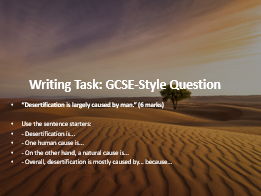



In this lesson, students will explore the complex causes of desertification and examine why certain areas—particularly semi-arid regions like the Sahel and Badia in Jordan—are especially vulnerable. Through group-based analysis using SOLO Taxonomy hexagons, students will identify and connect the physical and human factors driving desertification, such as climate change, population growth, and poor land management. By examining a real-world case study and building geographical links between causes, students will develop critical thinking skills and deepen their understanding of how environmental systems interact. The lesson culminates with a GCSE-style question to reinforce structured written responses and argument development.
Get this resource as part of a bundle and save up to 47%
A bundle is a package of resources grouped together to teach a particular topic, or a series of lessons, in one place.
The Middle-East unit plus booklet
Take your KS3 students on a journey through one of the most fascinating and misunderstood regions of the world with this engaging and fully resourced Middle East unit. This scheme of work introduces students to the physical geography, human landscapes, and contemporary challenges of the Middle East, including climate, conflict, resource management, and population dynamics. With case studies, enquiry-based tasks, and interactive activities—including map skills, data interpretation, and decision-making exercises—students develop a well-rounded and critical understanding of this diverse region. Perfect for deepening global awareness and building synoptic links across the geography curriculum.
The Middle-East KS3
Take your KS3 students on a journey through one of the most fascinating and misunderstood regions of the world with this engaging and fully resourced Middle East unit. This scheme of work introduces students to the physical geography, human landscapes, and contemporary challenges of the Middle East, including climate, conflict, resource management, and population dynamics. With case studies, enquiry-based tasks, and interactive activities—including map skills, data interpretation, and decision-making exercises—students develop a well-rounded and critical understanding of this diverse region. Perfect for deepening global awareness and building synoptic links across the geography curriculum.
Something went wrong, please try again later.
This resource hasn't been reviewed yet
To ensure quality for our reviews, only customers who have purchased this resource can review it
to let us know if it violates our terms and conditions.
Our customer service team will review your report and will be in touch.